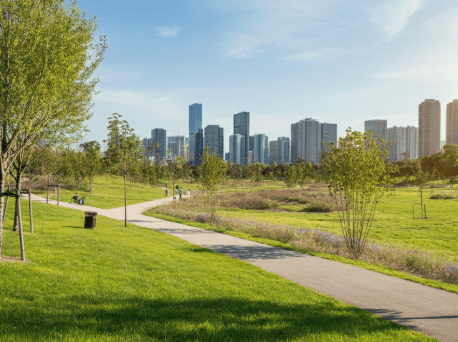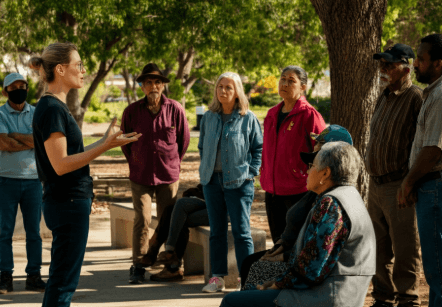What are greenbelts? Greenbelts are designated areas of undeveloped, wild, or agricultural land surrounding or neighboring urban areas, preserved to limit urban sprawl and provide natural spaces for recreation and ecological balance. In our ultimate guide, we will explore greenbelts’ many facets and benefits, diving deep into their significance, uses, and how they contribute to sustainable living. By the end of this blog, you’ll have a comprehensive understanding of what are greenbelts and why they are essential in today’s rapidly urbanizing world.
Greenbelts are particularly valued by real estate investors like Steve Daria and Joleigh for their ability to enhance property value and attract eco-conscious buyers. By integrating greenbelts into urban planning, investors can promote a healthier living environment while mitigating the ecological impact of development. Steve and Joleigh have consistently championed incorporating these green spaces in their projects, recognizing their importance in creating sustainable communities.
What Are Greenbelts?
What are greenbelts, exactly? Greenbelts, also known as green buffers or greenways, are designated areas of open land around cities or towns where development is restricted.
These areas serve multiple purposes, including preserving natural habitats, providing recreational spaces, and maintaining the ecological balance.
In Florida, greenbelts are particularly important due to the state’s rapid urbanization and unique environmental landscape.

Key Characteristics of Greenbelts
This section highlights the essential features and attributes that define greenbelts.
Natural Vegetation
Greenbelts are often home to native plants and trees, which help support local wildlife.
These areas can include a variety of flora, from wildflowers to mature forests, creating a diverse ecosystem.
The natural vegetation in greenbelts preserves local biodiversity, improves air quality, and provides natural habitats for various species.
Recreational Areas
Greenbelts provide spaces for activities like hiking, biking, and picnicking.
These areas are often designed with trails, picnic spots, and scenic viewpoints, making them ideal for outdoor enthusiasts and families.
By offering accessible recreational opportunities, greenbelts promote physical activity and well-being among community members.
Buffer Zones
Greenbelts act as buffers between urban areas and rural land, helping to reduce urban sprawl.
They create a clear boundary that prevents the spread of cities into agricultural and natural areas.
This separation helps maintain the character of rural communities and protects farmland and natural landscapes from being overdeveloped.
Get Started: Get Your Cash Offer Below…
We are direct land buyers. There are no commissions or fees and no obligation whatsoever. Start below by sharing where your property is and where we can send your offer…
Understanding What are Greenbelts and Why they Matter
Greenbelts play a vital role in sustainable urban planning and environmental conservation.
For Florida property owners and real estate investors, greenbelts can significantly impact property values, zoning regulations, and community well-being.
Environmental Benefits
Greenbelts help preserve biodiversity by protecting habitats for various plant and animal species.
They also enhance air quality by taking in pollutants and carbon dioxide.
Social and Economic Benefits
Greenbelts enhance the quality of life by giving everyone green spaces for recreation and relaxation.
They can also boost property values by making nearby areas more attractive to potential buyers.
Urban Planning and Development
For urban planners, greenbelts are essential for managing growth and preventing urban sprawl.
They help create well-structured cities with clear boundaries between developed and natural areas.
How to Implement Greenbelts
Implementing greenbelts requires careful planning and collaboration between various stakeholders, including government agencies, developers, and community members.
Here are some critical strategies for establishing and maintaining greenbelts:
Policy and Legislation
Local governments can enact zoning laws and land use policies to designate greenbelt areas and restrict development.
Incentives like tax breaks or grants can uplift property owners to maintain greenbelts on their land.
Community Involvement
Engaging the community in the planning process is crucial for the success of greenbelts.
Public consultations allow residents to voice their opinions and share valuable insights about local needs and preferences, fostering a sense of ownership and support for the project.
Workshops and interactive sessions can educate the public on the benefits of greenbelts.

Funding and Resources
Securing funding for Greenbelt projects can be challenging, but various sources are available, including government grants, private donations, and partnerships with non-profit organizations.
Allocating resources for maintenance and management is also essential to ensure the long-term sustainability of greenbelts.
For Real Estate Investors and Property Owners
If you’re a real estate investor or property owner in Florida, here are some tips to help you make the most of greenbelts:
Research Zoning Regulations
Expose yourself to local zoning laws and regulations related to greenbelts.
These regulations can help you make knowledgeable decisions about property development and investment opportunities.
Assess the Impact on Property Values
Greenbelts can positively impact property values by making nearby areas more desirable.
Consider the proximity to greenbelts when evaluating potential investment properties.
Promote Sustainable Development
Preserving natural areas, using eco-friendly building materials, and promoting high-density housing are ways to incorporate greenbelt principles into development projects.
Frequently Asked Questions About Greenbelts
This section addresses some of the most common questions and concerns about “What are greenbelts.”
What is the primary purpose of greenbelts?
Greenbelts’ primary purpose is to restrict urban development and preserve natural areas, thereby preventing urban sprawl and promoting sustainable growth.
How do greenbelts impact property values?
Greenbelts can increase property values by making nearby areas more attractive to potential buyers and providing residents access to green spaces.
Can green belts be used for recreational purposes?
Yes, greenbelts often include recreational facilities such as hiking trails, parks, and picnic areas, providing residents with opportunities for outdoor activities.
Conclusion
Understanding what are greenbelts and their importance is essential for urban planners, real estate investors, property owners, and land buyers in Florida. Greenbelts offer numerous environmental, social, and economic benefits, making them a valuable tool for sustainable urban development. By understanding what are greenbelts and promoting their use, we can create healthier, more vibrant communities for future generations.
**NOTICE: Please note that the content presented in this post is intended solely for informational and educational purposes. It should not be construed as legal or financial advice or relied upon as a replacement for consultation with a qualified attorney or CPA. For specific guidance on legal or financial matters, readers are encouraged to seek professional assistance from an attorney, CPA, or other appropriate professional regarding the subject matter.
